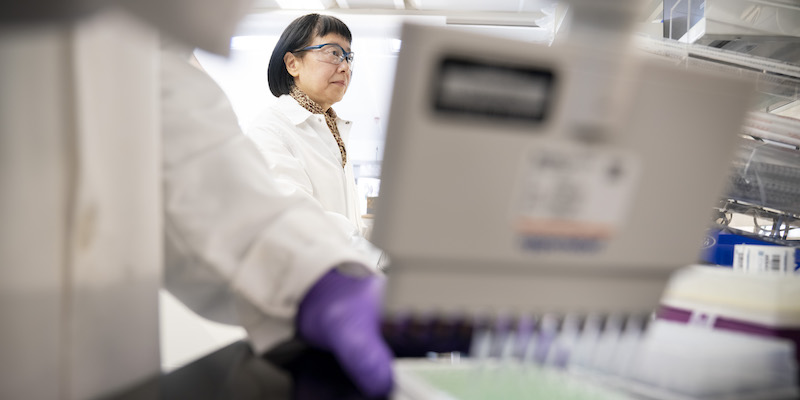Neurons are central nervous system (CNS) cells that receive and transmit electrochemical signals by a process called neurotransmission. Neuronal anatomy is specialized to receive and send information from neighboring cells. Neuronal axons send signals while dendrites receive information from other cells. Neuroscience research has greatly expanded our understanding of how these specialized cells function and communicate.
A neuron is categorized as excitatory or inhibitory based on the type of signal it releases. These signals can hyperpolarize or depolarize their target neurons. Other characteristics that contribute to the classification of a neuron include polarity, morphology, anatomical location, protein expression profile, and directional flow of information.
|
|
Explore the Functional Neuron Marker Antibody Sampler Kit #48510, which contains reagents to many of the targets mentioned in this post:
|
What are neurotransmitters and what do they do?
Neurotransmission from the neuron and extraneural systems moves through a series of intracellular events to mediate the propagation of the electrical signal. The extracellular space between two cells is the synapse, and therefore the signal origin is the presynaptic cell, and the receiving neuron is the postsynaptic cell.
Neurotransmitters are signaling molecules that generate an excitatory or inhibitory response on the postsynaptic membrane, thereby propagating or preventing an action potential.
 |
Explore the interactive Post-Synaptic Signaling Pathway Diagram to see key protein targets and associated CST products. |
Neurotransmitters can be categorized as small molecules or neuropeptides. The synthesis of small molecule neurotransmitters occurs locally—within the axon terminal, while neuropeptides are much larger than small molecules, and therefore are synthesized within the cell body.
Amino Acids
- Glutamate: The most common neurotransmitter in the CNS, glutamate is widely expressed in the brain. It is excitatory by nature and plays a major role in memory and learning.
- GABA (gamma-aminobutyric acid): An inhibitory neurotransmitter with a wide range of functions, including thecregulation of anxiety.
- Aspartate: An excitatory neurotransmitter expressed in the ventral spinal cord.

Explore the interactive Vesicle Trafficking Presynaptic Signaling Pathway Diagram to see key protein targets and associated CST products.
Monoamines
- Dopamine: A neuromodulatory neurotransmitter known to play a role in mood and addiction, but also plays a major role in controlling posture and movement. Decreased dopamine expression in the brain is linked to muscle dysfunction in Parkinson’s disease.

Explore the interactive Dopamine Signaling in Parkinson's Disease Pathway Diagram to see key protein targets and associated CST products.
- Serotonin: An inhibitory neurotransmitter known to stabilize mood and also to regulate the sleep cycle.
- Norepinephrine: An excitatory neurotransmitter released from the adrenal glands in order to increase alertness. Anxiety has been linked to extremely high levels of norepinephrine.
- Epinephrine (Adrenaline): An excitatory neurotransmitter that stimulates the “fight or flight” reaction by the body by increasing the heart rate and blood pressure.
- Histamine: An excitatory neurotransmitter involved in inflammatory responses and vasodilation.
Peptides
- Neuropeptide Y: An inhibitory neurotransmitter that plays a role in adipogenesis, satiety, and vasoconstriction.
- Somatostatin: An inhibitory neurotransmitter produced in the digestive system as well as the hypothalamus, and functions to inhibits insulin and glucagon secretion.
Other Neurotransmitters
- ATP: An Important mediator in neuronal and glial cell signaling by increasing the speed of postsynaptic signal transmission.
- Adenosine: A Degradation product of ATP that inhibits acetylcholine release and increases cAMP; is neuroprotective under conditions of hypoxia, ischemia, and neuroinflammation.
- Acetylcholine: An excitatory neurotransmitter that plays a critical role in muscle function.
- Nitric Oxide: An oxidative radical that is a potent vasodilator and has the ability to induce the release of acetylcholine, catecholamine, and other neurotransmitters.
What is neurotransmission and how does it occur?
The release of neurotransmitters is dependent on changes in intracellular voltage - which is mediated by ligand and gated ion channels in the presynaptic cell. Depolarization of the cell results in action potential propagation through the entire axon. At the presynaptic terminal, calcium influx stimulates the extracellular release of the neurotransmitter vesicles.
After traversing the synapse, neurotransmitters bind to postsynaptic receptors on the dendrites and exert either an excitatory or inhibitory response.
Following the action potential, the presynaptic cell repolarizes using the action of ion channels and ATP-dependent transporters. Neurotransmission is terminated by neurotransmitter enzymatic degradation in the synaptic cleft, transported-mediated recycling to its original axon terminal, or by transporter-mediated astrocytic uptake.









